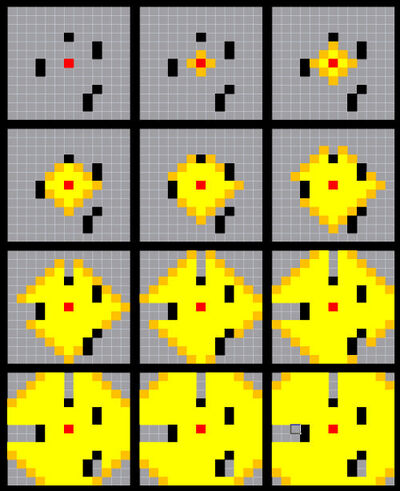Fourgreenfields (talk | contribs) (→Explosive damage: Info was obsolete, due to explosion-algorithm overhaul;) |
Fourgreenfields (talk | contribs) (changed names of subcategories (e.g. Thump damage vs Thump Damage)) |
||
| Line 7: | Line 7: | ||
where AP is the shell AP, and AC is the combined armour of the blocks being hit. For a single block, the AC corresponds to its armour. Thus, for a single block, full damage is reached when AP is 2 times the armour of the block. |
where AP is the shell AP, and AC is the combined armour of the blocks being hit. For a single block, the AC corresponds to its armour. Thus, for a single block, full damage is reached when AP is 2 times the armour of the block. |
||
| − | === Layered |
+ | === Layered Armour === |
Against explosive or kinetic damage, "structural" blocks (namely [[wood]], [[stone]], [[metal]], [[Heavy Armour|heavy armour]], and [[light-weight Alloy|alloy]]) behind a block being damaged will contribute part of its armour to the AC of the block being hit. The percentage contributed is as follows: |
Against explosive or kinetic damage, "structural" blocks (namely [[wood]], [[stone]], [[metal]], [[Heavy Armour|heavy armour]], and [[light-weight Alloy|alloy]]) behind a block being damaged will contribute part of its armour to the AC of the block being hit. The percentage contributed is as follows: |
||
| Line 33: | Line 33: | ||
For example, for 5 layers of Metal (armour class 15), the outside layer would have 61.5 Armour class because the 4 layers behind it would add an additional 46.5 armour class (15 + 12.75 + 10.5 + 8.25) to the original 15. This is only the armour of the '''outside layer''', this effect applies to all layers of armour, meaning that the outside layer has 61.5, the 2nd layer has 53.25, the 3rd layer has 42.75, etc. [https://docs.google.com/spreadsheets/d/1cTyT4O75FMob8sptz7Nejl4ljViBOWEU3zu-fWHIGI4/edit#gid=0 Here is a calculator] made by [http://www.fromthedepthsgame.com/forum/showthread.php?tid=15910 Zuthal] in google sheets to make things easier, as well as a slightly [https://docs.google.com/spreadsheets/d/1os_knk1TcUaQOiMpiSLm7b0qf99D0iAPptRyJp2xZJM/edit?usp=sharing modified version] (not updated to current values) that may be easier to use. It is based on kinetic damage only, and does not factor in angle. However, it gives a good representation of armour class of each layer of armour, as well as the required damage to get through each layer. |
For example, for 5 layers of Metal (armour class 15), the outside layer would have 61.5 Armour class because the 4 layers behind it would add an additional 46.5 armour class (15 + 12.75 + 10.5 + 8.25) to the original 15. This is only the armour of the '''outside layer''', this effect applies to all layers of armour, meaning that the outside layer has 61.5, the 2nd layer has 53.25, the 3rd layer has 42.75, etc. [https://docs.google.com/spreadsheets/d/1cTyT4O75FMob8sptz7Nejl4ljViBOWEU3zu-fWHIGI4/edit#gid=0 Here is a calculator] made by [http://www.fromthedepthsgame.com/forum/showthread.php?tid=15910 Zuthal] in google sheets to make things easier, as well as a slightly [https://docs.google.com/spreadsheets/d/1os_knk1TcUaQOiMpiSLm7b0qf99D0iAPptRyJp2xZJM/edit?usp=sharing modified version] (not updated to current values) that may be easier to use. It is based on kinetic damage only, and does not factor in angle. However, it gives a good representation of armour class of each layer of armour, as well as the required damage to get through each layer. |
||
| − | == Kinetic |
+ | == Kinetic Damage == |
Kinetic damage is dealt by fragmentation warheads and all cannons. The amount of damage dealt depends on the impact angle. |
Kinetic damage is dealt by fragmentation warheads and all cannons. The amount of damage dealt depends on the impact angle. |
||
| Line 59: | Line 59: | ||
|} |
|} |
||
| − | == Thump |
+ | == Thump Damage == |
Unlike kinetic damage, thump damage spreads the remaining damage to adjacent blocks whenever destroying a block. This prevents overkill (piercing an entire enemy craft, and still having damage left). Thump damage ignores armour-layering. |
Unlike kinetic damage, thump damage spreads the remaining damage to adjacent blocks whenever destroying a block. This prevents overkill (piercing an entire enemy craft, and still having damage left). Thump damage ignores armour-layering. |
||
| Line 70: | Line 70: | ||
* [[Ram]]s (AP 15) |
* [[Ram]]s (AP 15) |
||
| − | == Laser |
+ | == Laser Damage == |
Laser damage is dealt by [[lasers]]. |
Laser damage is dealt by [[lasers]]. |
||
| Line 76: | Line 76: | ||
Damage is reduced by smoke and water. |
Damage is reduced by smoke and water. |
||
| − | == Explosive |
+ | == Explosive Damage == |
Explosive damage is dealt by [[CRAM]]s with HE-pellets, [[Advanced Cannon]]s or [[Missile]]s with HE-, or flak-warheads, by explosive [[Particle Cannon|PAC]]s and by exploding blocks. |
Explosive damage is dealt by [[CRAM]]s with HE-pellets, [[Advanced Cannon]]s or [[Missile]]s with HE-, or flak-warheads, by explosive [[Particle Cannon|PAC]]s and by exploding blocks. |
||
| Line 90: | Line 90: | ||
[[File:ExplosionPropagation.jpg|400px]] |
[[File:ExplosionPropagation.jpg|400px]] |
||
| − | == EMP |
+ | == EMP Damage == |
EMP damage is dealt by advanced cannons and missiles with EMP Warheads. |
EMP damage is dealt by advanced cannons and missiles with EMP Warheads. |
||
Revision as of 11:24, 13 January 2019
Armour
Most damage is subject to armour mechanics. Unless stated otherwise, damage is multiplied by
where AP is the shell AP, and AC is the combined armour of the blocks being hit. For a single block, the AC corresponds to its armour. Thus, for a single block, full damage is reached when AP is 2 times the armour of the block.
Layered Armour
Against explosive or kinetic damage, "structural" blocks (namely wood, stone, metal, heavy armour, and alloy) behind a block being damaged will contribute part of its armour to the AC of the block being hit. The percentage contributed is as follows:
| Additional layer | Contribution |
|---|---|
| 1 | 100% |
| 2 | 85% |
| 3 | 70% |
| 4 | 55% |
| 5 | 40% |
| 6 | 25% |
| 7 | 10% (vs. kinetic only) |
| 8 | 10% (vs. kinetic only) |
For example, for 5 layers of Metal (armour class 15), the outside layer would have 61.5 Armour class because the 4 layers behind it would add an additional 46.5 armour class (15 + 12.75 + 10.5 + 8.25) to the original 15. This is only the armour of the outside layer, this effect applies to all layers of armour, meaning that the outside layer has 61.5, the 2nd layer has 53.25, the 3rd layer has 42.75, etc. Here is a calculator made by Zuthal in google sheets to make things easier, as well as a slightly modified version (not updated to current values) that may be easier to use. It is based on kinetic damage only, and does not factor in angle. However, it gives a good representation of armour class of each layer of armour, as well as the required damage to get through each layer.
Kinetic Damage
Kinetic damage is dealt by fragmentation warheads and all cannons. The amount of damage dealt depends on the impact angle.
The kinetic damage is computed by multiplying the total kinetic damage of the shell by the standard multiplier above. If the damage is sufficient to destroy the block hit, the damage used to destroy the block (i.e. net damage divided by ) is subtracted from the projectile's damage potential and the projectile continues on its path.
When striking from outside (i.e. not just having destroyed the previous block in its path), kinetic damage is reduced to a factor . If the projectile fails to destroy the initial block, it has a chance of ricocheting of
in which case the remaining damage potential is reduced by the net damage dealt divided by . If the projectile does not ricochet, the remaining damage potential is reduced by the net damage dealt divided by .
For the various slopes:
| Slope | Angle | Damage multiplier for horizontal hit | Damage multiplier for hit from 45° up | Damage multiplier for hit 90° up |
|---|---|---|---|---|
| 1m | 45.00° | 0.707 | 1.000 | 0.707 |
| 2m | 63.43° | 0.447 | 0.949 | 0.894 |
| 3m | 71.57° | 0.316 | 0.894 | 0.949 |
| 4m | 75.96° | 0.243 | 0.858 | 0.970 |
Thump Damage
Unlike kinetic damage, thump damage spreads the remaining damage to adjacent blocks whenever destroying a block. This prevents overkill (piercing an entire enemy craft, and still having damage left). Thump damage ignores armour-layering.
Thump damage is dealt by:
- Hollow point and squash head shells (AP 10)
- Impact particle cannons (AP 15)
- All missiles, increased using bodies, thumper heads, and using empty space for reinforcement (AP 20)
- Collisions (AP 1)
- Rams (AP 15)
Laser Damage
Laser damage is dealt by lasers.
Damage is reduced by smoke and water.
Explosive Damage
Explosive damage is dealt by CRAMs with HE-pellets, Advanced Cannons or Missiles with HE-, or flak-warheads, by explosive PACs and by exploding blocks.
Explosions cannot affect anything more than 30 metres from their origin, even if their rated radius is larger. However, if a vehicle is outside the 30m radius, but still inside the listed radius, the explosion will "snap" to the vehicle, damaging blocks within 30m from the closest point. This matters little for HE, but is quite noticeable on flak-shells.
The exact calculations for explosions are quite complex. If an explosion propagates through air, it will lose power. If it lacks power to deal meaningful damage to a block, it may do no damage, getting part of its power refunded. In effect, this means that explosions deal more damage in closed rooms (strengthening APHE), and will seek out weak spots in armour (making exposed vitals quite vulnerable).
Propagation
Explosions take subobjects (turrets, spinners, pistons) and the main construct (hull) into account. Blocks will block explosions as follows, regardless of whether they're placed on the hull or a subobject:
EMP Damage
EMP damage is dealt by advanced cannons and missiles with EMP Warheads.
EMP damage is not subject to reduction from armour.
When a construct is hit by EMP damage, a charge is created with damage potential equal to the rated damage. The charge propagates from block to block. Upon visiting a block:
- The EMP charge deals damage equal to the EMP susceptibility of the block times the damage potential, but not more than is needed to destroy the block. The dealt damage is subtracted from the damage potential.
- The protective drainage of the block is subtracted from the damage potential.
The pathfinding algorithm operates similarly to Dijikstra's algorithm, but instead of choosing the node (block) with the shortest total path at each iteration, it chooses the node which maximizes the amount of total damage dealt minus the amount of total damage lost to protective drainage on the path to that node. The search terminates after 1000 nodes have been visited, the charge used (damage dealt + protective drainage) reaches 1.2 times the original damage potential, or no more nodes are reachable. At this point the visited node with the highest damage dealt on the path to that node is chosen. Surge Protectors count as taking full damage for purposes of the propagation decision.






